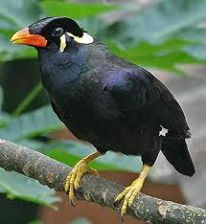
Always Love with birds

Always Love with birds
Pheasants refer to some members of the Phasianinae (Horsfield, 1821) subfamily of Phasianidae in the order Galliformes.
Pheasants are characterised by strong sexual dimorphism, males being highly ornate with bright colours and adornments such as wattles and long tails. Males are usually larger than females and have longer tails. Males play no part in rearing the young. Pheasants typically eat seeds and some insects.
The best-known is the Common Pheasant, which is widespread throughout the world in introduced feral populations and in farm operations. Various other pheasant species are popular in aviaries, such as the Golden Pheasant

The myna or mynah is a bird of the starling family (Sturnidae). This is a group of passerine birds which occur naturally only in southern and eastern Asia, especially in India & Pakistan. Several species have been introduced to areas like North America, Australia, South Africa and New Zealand, especially the Common Myna which is often regarded as an invasive species. Mynas are not a natural group (Zuccon et al. 2006); instead, the term myna is used for any starling in India, Pakistan and surrounding areas, regardless of their relationships. This range was colonized twice during the evolution of starlings, first by rather ancestral starlings related to the Coleto and Aplonis lineages, and millions of years later by birds related to the Common Starling and Wattled Starling’s ancestors. These two groups of mynas can be distinguished in the more terrestrial adaptions of the latter, which usually also have less glossy plumage except on the heads and longer tails. The Bali Myna which is nearly extinct in the wild is highly distinctive. Some mynas are considered talking birds, for their ability to reproduce sounds, including human speech, when in captivity. “Myna” is derived from the Hindi or Urdu language mainā which itself is derived from Sanskrit madanā.
Pheasants refer to some members of the Phasianinae (Horsfield, 1821) subfamily of Phasianidae in the order Galliformes.
Pheasants are characterised by strong sexual dimorphism, males being highly ornate with bright colours and adornments such as wattles and long tails. Males are usually larger than females and have longer tails. Males play no part in rearing the young. Pheasants typically eat seeds and some insects.
The best-known is the Common Pheasant, which is widespread throughout the world in introduced feral populations and in farm operations. Various other pheasant species are popular in aviaries, such as the Golden Pheasant
The Gouldian Finch, (Erythrura gouldiae), also known as the Lady Gouldian Finch, Gould’s Finch or the Rainbow Finch, is a colorful passerine bird endemic to Australia. There is strong evidence of a continuing decline, even at the best-known site near Katherine in the Northern Territory. Large numbers are bred in captivity, particularly in Australia. In the state of South Australia, National Parks & Wildlife Department permit returns in the late 1990s showed that over 13,000 Gouldian Finches were being kept by aviculturists. If extrapolated to an Australia-wide figure this would result in a total of over 100,000 birds. In 1992, it was classified as “Endangered in the wild” under IUCN’s criteria C2ai. This was because the viable population size was estimated to be less than 2,500 mature individuals, no permanent subpopulation was known to contain more than 250 mature individuals, and that a continuing decline was observed in the number of mature individuals. It is currently subject to a conservation program.
The Fischer’s Lovebird (Agapornis fischeri) is a small parrot species of the Agapornis genus. They were originally discovered in the late 19th century, and were first bred in the United States in 1926. They are named after German explorer Gustav Fischer. All the lovebird varieties, the Fischer’s Lovebird are the most prominent if not one of the majority beautiful parrots available on the markets (Africa, USA, UAE, Asia & Africa). The Fischer’s Lovebird has a green back, chest, and wings. Their necks are a golden yellow and as it progresses upward it becomes darker orange.